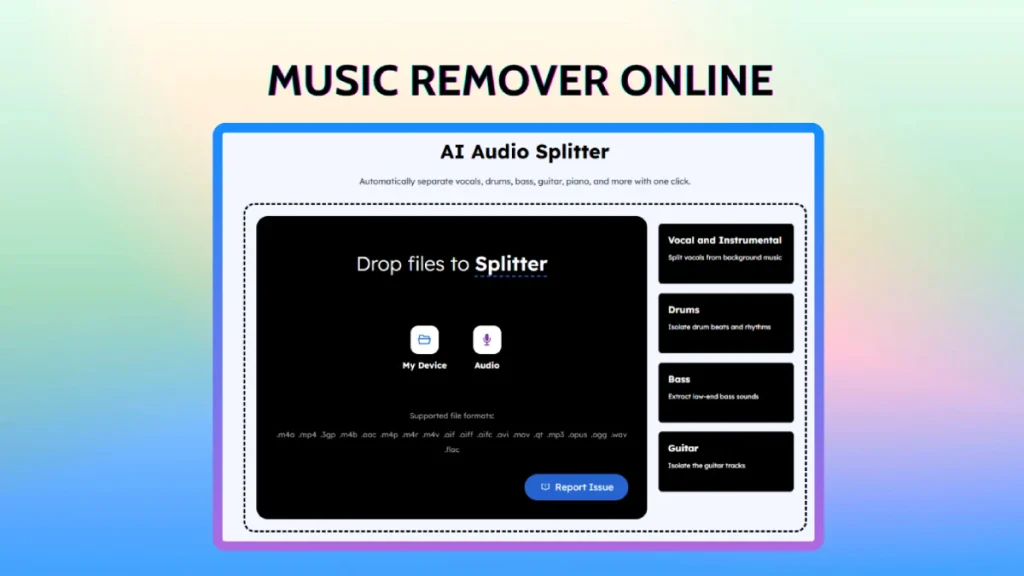The Creator's Guide to Removing Music from Video Content

The creator economy has exploded, but so have the legal landmines. Every day, millions of videos get uploaded with copyrighted music, often unintentionally. A restaurant’s background playlist, a car radio, or even a street musician can turn your masterpiece into a liability. That’s why learning to remove music from video content isn’t just a technical skill – it’s essential self-defense for anyone serious about content creation.
The New Reality of Video Platform Policing
Platform algorithms have become ruthlessly efficient at detecting copyrighted content. YouTube’s Content ID system scans over 100 hours of video uploaded every minute, flagging potential violations in real-time. TikTok’s detection goes deeper, analyzing not just obvious music but ambient audio that might contain copyrighted elements. Instagram and Facebook have joined this arms race, making it nearly impossible to slip past their automated gatekeepers.
The financial stakes keep rising. Beyond immediate takedowns, creators face demonetization, channel strikes, and permanent bans. For businesses using video marketing, the risks extend to legal action from rights holders who view unauthorized use as lost licensing revenue. Even educational institutions and non-profits aren’t immune – fair use defenses are expensive to mount and uncertain to win.
Content reuse presents another layer of complexity. A single video might need multiple versions: one for YouTube with licensed music, another for LinkedIn without any background audio, and a third for internal training with completely different sound design. Music remover from video technology has become essential infrastructure for content creators who need flexibility in how they distribute their work.
The economics are compelling. Professional music licensing can cost hundreds or thousands of dollars per track, while a single copyright strike can cost months of lost revenue. The ability to cleanly remove music from video content provides both creative freedom and financial protection.
From Impossible to Effortless: The Music Remover Technical Revolution
Traditional approaches relied on frequency filtering – essentially guessing which parts of the audio spectrum contained music versus dialogue. The results were consistently disappointing: voices sounded hollow, important audio got lost, and artifacts made the final product unusable.
Machine learning changed everything. Modern video music remover algorithms use neural networks trained on massive datasets of isolated audio sources. They can identify the difference between a human voice and a violin, between natural speech patterns and synthesized instruments.
Processing speed has improved dramatically. Cloud-based solutions can analyze and process hour-long videos in minutes, while local processing on modern hardware handles most content in real-time. Mobile apps now offer capabilities that required professional studios just a few years ago.
Quality improvements are equally impressive. Voice Cleaner AI Free Online preserves audio fidelity while achieving clean separation between desired and unwanted elements. The artificial artifacts that plagued earlier solutions have largely disappeared, replaced by natural-sounding results that maintain the original content’s professional quality.
Navigating Video Music Remover Tool Landscape
The market has exploded with options, from simple mobile apps to enterprise-grade software solutions. Quality remains the primary differentiator, but defining quality requires understanding your specific needs and constraints.
Processing capabilities vary significantly. Some tools excel at simple background music removal but struggle with complex audio mixes. Others handle orchestral soundtracks beautifully but may over-process simple dialogue. The best music remover from video solutions offer adjustable processing parameters that let you optimize results for your content type.
File format support matters more than most creators realize. Different platforms prefer different video codecs, audio bitrates, and resolution settings. Professional workflows often require specific output formats for downstream processing. Look for tools that support your entire production pipeline without requiring additional conversion steps.
The pricing landscape includes everything from premium professional software to excellent Free AI Audio Cleaner Online solutions like AudioCleaner that deliver surprisingly sophisticated results. Many creators find that free tools handle their needs perfectly, especially for social media content and basic video editing. These solutions often leverage the same underlying AI technology as expensive alternatives, democratizing professional-quality audio processing.

Real-World Applications Across Content Types
Social media creators face unique challenges with background audio. Lifestyle videos filmed in public spaces, travel content recorded in restaurants or cafes, and street interviews often capture unwanted background music. The ability to quickly remove music from video content means faster publishing schedules and reduced copyright risk.
Corporate video production has embraced these tools for compliance and flexibility. Training videos, product demonstrations, and conference recordings often contain background music that creates licensing complications. Professional teams use video music remover technology to create clean versions suitable for different distribution contexts.
Educational content creators deal with similar issues. University lectures recorded in common areas, online course materials filmed at home, and tutorial videos created in shared spaces frequently include background audio that distracts from the educational message. Clean audio improves learning outcomes and professional presentation.
Live streaming and event recording present special challenges. Conferences, webinars, and live performances often include copyrighted music during breaks or transitions. Post-event processing to remove music from video recordings enables broader distribution and archival use without licensing concerns.
The podcasting world has increasingly embraced video formats, creating new audio processing needs. Video podcasts filmed in public spaces or co-working environments often require background music removal for professional presentation and platform compliance.
Conclusion
For creators building sustainable businesses around video content, mastering the ability to remove music from video content provides both creative freedom and legal protection. As platforms become more aggressive about copyright enforcement and audiences more demanding about audio quality, these skills transition from helpful to essential for long-term success.
